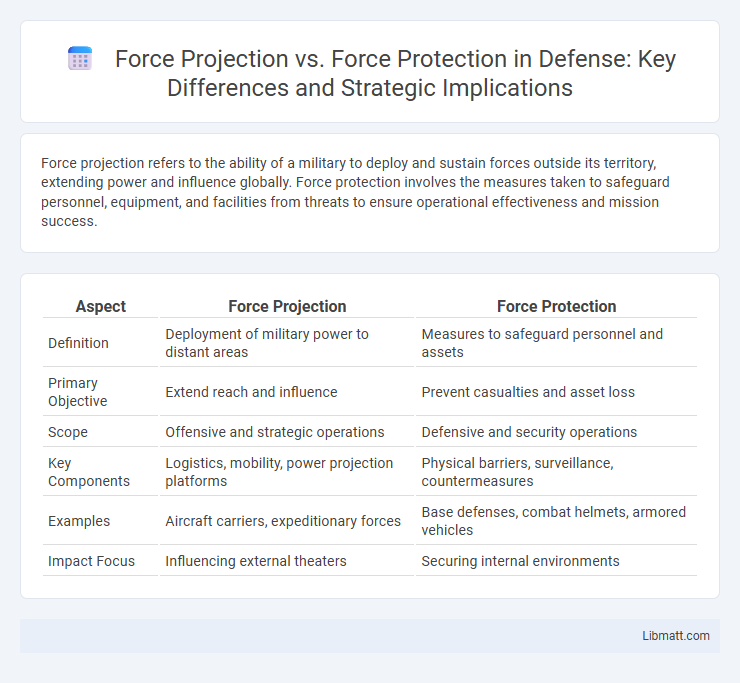Force projection refers to the ability of a military to deploy and sustain forces outside its territory, extending power and influence globally. Force protection involves the measures taken to safeguard personnel, equipment, and facilities from threats to ensure operational effectiveness and mission success.
Table of Comparison
| Aspect | Force Projection | Force Protection |
|---|---|---|
| Definition | Deployment of military power to distant areas | Measures to safeguard personnel and assets |
| Primary Objective | Extend reach and influence | Prevent casualties and asset loss |
| Scope | Offensive and strategic operations | Defensive and security operations |
| Key Components | Logistics, mobility, power projection platforms | Physical barriers, surveillance, countermeasures |
| Examples | Aircraft carriers, expeditionary forces | Base defenses, combat helmets, armored vehicles |
| Impact Focus | Influencing external theaters | Securing internal environments |
Understanding Force Projection: Definition and Importance
Force projection is the ability of a military to deploy and sustain forces outside its territory to influence events and achieve strategic objectives. It involves rapid mobilization, logistical support, and power projection through air, sea, or land, enabling a nation to respond to threats or crises globally. Understanding your ability to project force is crucial for maintaining strategic advantage and ensuring operational readiness in diverse conflict scenarios.
The Concept of Force Protection in Modern Warfare
Force protection in modern warfare emphasizes safeguarding military personnel, equipment, and facilities from threats through comprehensive measures such as physical security, intelligence, and counter-terrorism tactics. Effective force protection reduces vulnerability to enemy attacks, including insurgents, cyber threats, and missile strikes, ensuring sustained operational capability. This concept integrates technological advancements, risk assessment, and rapid response to mitigate dangers in dynamic combat environments.
Key Differences Between Force Projection and Force Protection
Force projection emphasizes the ability to deploy and sustain military power rapidly beyond a nation's borders to achieve strategic objectives, while force protection focuses on safeguarding personnel, equipment, and facilities from hostile actions. Force projection involves offensive operations, mobility, and logistical support, whereas force protection prioritizes defensive measures, threat mitigation, and securing operational environments. Understanding these key differences helps you balance offensive capabilities with defensive readiness in military planning.
Historical Examples of Force Projection Strategies
Force projection strategies have been exemplified historically by the Roman Empire's extensive road networks and legion deployments, enabling rapid military response across vast territories. The British Royal Navy's dominance during the 18th and 19th centuries showcased force projection by securing sea lanes and colonial outposts worldwide. Understanding these strategies can help you grasp how military powers extend influence far beyond their borders through strategic positioning and mobility.
Force Protection Measures: Tactics and Technologies
Force protection measures encompass a range of tactics and technologies designed to safeguard military personnel, equipment, and facilities from threats. These include physical barriers, surveillance systems, electronic countermeasures, and personnel training in threat detection and response. Your ability to integrate advanced sensors and rapid-deployment protocols enhances the effectiveness of these protective strategies in hostile environments.
Balancing Offensive and Defensive Military Objectives
Balancing offensive force projection with defensive force protection requires strategic allocation of military resources to extend your operational reach while safeguarding personnel and assets. Force projection emphasizes rapid deployment and the ability to influence adversaries beyond borders, whereas force protection prioritizes minimizing vulnerabilities through robust defense systems, intelligence, and secure logistics. Effective military planning integrates these approaches to maintain combat effectiveness while reducing risks in volatile environments.
Challenges in Implementing Force Projection
Challenges in implementing force projection include logistical complexities, such as transporting and sustaining troops and equipment over long distances, often through hostile or uncertain environments. Securing reliable intelligence and establishing effective communication networks are critical to overcoming operational risks and maintaining strategic advantage. Your mission's success depends on balancing rapid deployment capabilities with robust support infrastructure to mitigate vulnerabilities during extended operations.
Innovations Enhancing Force Protection Capabilities
Innovations enhancing force protection capabilities include advanced surveillance technologies, such as unmanned aerial systems (UAS) and AI-powered threat detection, which improve situational awareness and early warning. Improved armor materials like composite and reactive armor boost vehicle survivability against emerging threats, while integrated cyber defense systems safeguard communication networks from hostile intrusions. These advancements empower your forces to operate securely in complex and contested environments, reducing vulnerabilities and enhancing overall mission resilience.
Force Projection vs Force Protection: Impact on Military Success
Force projection enables military success by extending a nation's power beyond its borders through rapid deployment of troops and equipment, establishing dominance in critical regions. Force protection ensures the safety and effectiveness of deployed forces by minimizing casualties and maintaining operational readiness in hostile environments. Balancing force projection with robust force protection measures maximizes Your military's strategic advantage and mission endurance.
Future Trends in Force Projection and Force Protection
Future trends in force projection emphasize advanced long-range missile systems, autonomous drones, and integrated multi-domain operations to enhance rapid global reach and precision strike capabilities. Force protection increasingly incorporates AI-driven surveillance, cyber defense measures, and resilient infrastructure to safeguard personnel and assets against evolving threats. Your ability to balance these technological advancements will determine operational effectiveness in dynamic combat environments.
Force projection vs Force protection Infographic

 libmatt.com
libmatt.com